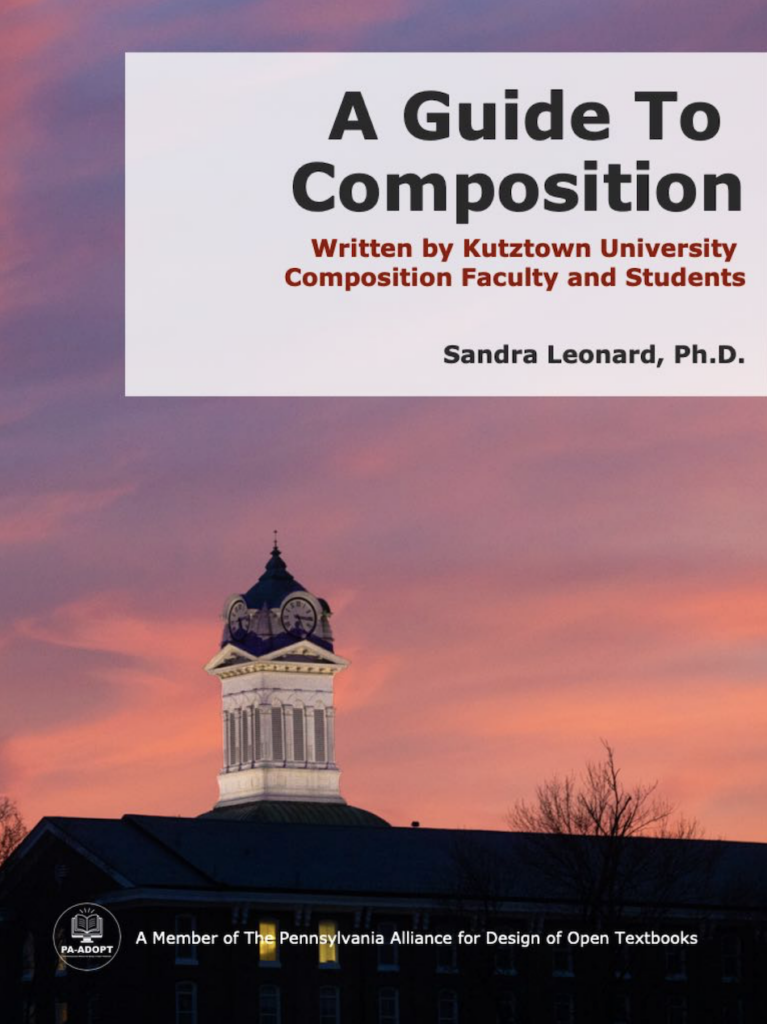A Guide to Composition
by Sandra Leonard, Ph.D.
Written by Kutztown University Composition Faculty and Students
Keywords: Composition, Writing, Rhetoric, Research

About the Book
A Guide to Composition (2025) is an introduction to college writing and research. The text begins by defining basic principles of rhetoric and composition using popular texts such as advertisements, speeches, and news media. This textbook then moves to the specific genres of narrative and argument. Elements of the writing process are emphasized throughout the text in addressing writing center use, idea generation, library use, peer review, and ethical attribution including some discussion of A.I. Each chapter is written by current or former Kutztown University faculty and students, making it particularly well-suited to Kutztown University students; however, chapters two through eight are particularly inviting to wider audiences. Each chapter contains a number of writing process activities that may be useful as classroom activities or homework assignments.
Chapters
Assignments and Activities
Preface: Welcome to Composition
Chapter 1: Using the Writing Center at KU
Chapter 2: The Rhetorical Situation
Chapter 3: The Shape of Rhetoric
Chapter 4: Telling Stories with Narrative Writing Conventions
Chapter 5: Generating Ideas and Writing Topic Proposals
Chapter 6: Strategies of Organization
Chapter 7: Grammar and Mechanics
Chapter 8: Practicing Better Peer Feedback
Chapter 9: Using the Rohrbach Library
Chapter 10: Ethical and Effective Attribution
Afterword: Writing For and Beyond KU
General Information
- Publication Year: 2025
- Edition: First
- Subject: Writing
License

This work is licensed under a Creative Commons Attribution-NonCommercial-ShareAlike 4.0 International (CC BY-NC-SA 4.0) as a part of PA-ADOPT, except where otherwise noted.
Usage
Readers
The eTextbooks created as a part of this program are provided in two formats: ePub and PDF. Please refer to our Reader Support section for guidance on which format may be best for you and the device(s) you use.
Instructors
If you are an instructor seeking to use this eTextbook in your own course(s) please feel free to download the ePub and/or PDF file(s) for your use, but make sure to complete our eTextbook Usage Survey (this information is used for program evaluation purposes).
If you are interested in making revisions and edits to this eTextbook please note that this is possible since the book is under a Creative Commons License, which allows you to remix, reuse, revise, and redistribute the eTextbook. Please refer to the Faculty Support Page, specifically looking at Remixing. You can download A Guide to Composition Apple Pages File in order to use the original document to revise and remix the eTextbook for your purposes.
Citations
MLA: Leonard, Sandra. A Guide to Composition. First, The Pennsylvania Alliance for Design of Open Textbooks (PA-ADOPT), 2025.
APA: Leonard, S. (2025). A Guide to Composition. (First). The Pennsylvania Alliance for Design of Open Textbooks (PA-ADOPT).
Chicago: Leonard, Sandra. A Guide to Composition. First. The Pennsylvania Alliance for Design of Open Textbooks (PA-ADOPT), 2025.
Peer Review
This eTextbook went through an Open Peer Review process. The peer review process used the Open SUNY Textbook Peer Review Guidelines, allowing peer reviewers to read the text carefully and evaluate the following:
- Educational Significance of Content including accuracy, appropriate and useful materials, valid and significant concepts, models, and skills, and key elements;
- Effectiveness as a Teaching Resource including a clear explanation of the concepts, alignment of materials to the learning process of the target audience, and alignment of the learning objectives with course goals; and
- Readability and Ease of Use including clarity and comprehensiveness, consistent writing style, readability and ease of use (logic, sequence, and flow), appropriateness for target readership level, and quality of Interactivity and multimedia learning objects.
As a part of the open peer review process, the public review conducted by Dr. Colleen Clemens is made available: Peer Review Document (PDF).